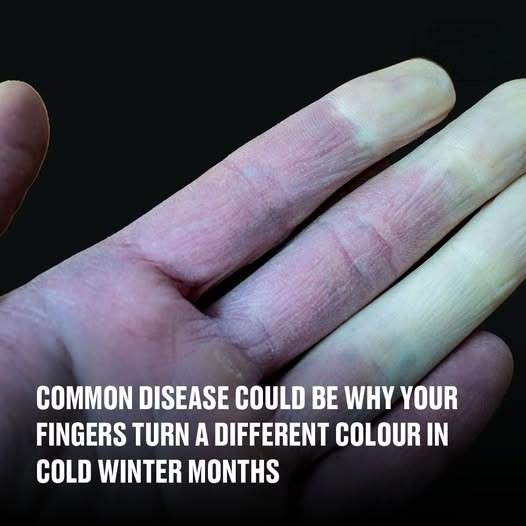When winter sets in, it’s common for people to experience cold hands and feet. But if your fingers or toes turn pale white, blue, or even dark red in cold weather, it might not just be a normal response to chilly temperatures. This noticeable color change, often accompanied by discomfort, numbness, or pain, could actually be a sign of Raynaud’s disease, a condition that affects blood circulation in the extremities. While many people may dismiss these symptoms as a harmless quirk, understanding Raynaud’s is essential for proper management and improved quality of life during colder months.

So, what exactly is Raynaud’s disease? Also known as Raynaud’s phenomenon, this condition affects how your blood vessels respond to cold temperatures or stress. When exposed to cold or emotional stress, the small arteries supplying blood to your fingers and toes can constrict excessively. This sudden narrowing of blood vessels reduces blood flow to these areas, causing them to change color dramatically. Instead of simply feeling cold, those with Raynaud’s often notice their fingers turning pale white, then blue, and finally red as blood flow returns. This phenomenon is not limited to the fingers—it can also affect toes, ears, lips, nose, and even nipples.
According to Dr. Melisa Lai Becker, who spoke to Good Morning America, “For most people, chilly weather might make their fingers cold, but with Raynaud’s, the hands can turn ice-cold and visibly change color.” The discomfort can range from mild numbness to intense pain, and the severity of symptoms varies widely among individuals. While some people experience only minor inconvenience, others may find it challenging to complete simple daily tasks like typing, buttoning a shirt, or even holding a cup of coffee.
What causes Raynaud’s disease? The condition can be classified into two types: primary Raynaud’s and secondary Raynaud’s. Primary Raynaud’s is more common and occurs on its own without any other underlying health issues. It’s generally milder and easier to manage. Secondary Raynaud’s, on the other hand, is linked to other medical conditions such as lupus, scleroderma, or rheumatoid arthritis. Certain medications, including beta-blockers, migraine treatments, or chemotherapy drugs, can also trigger Raynaud’s symptoms. Smoking, exposure to vibrating tools, and prolonged stress may further increase the risk.
What are the symptoms of Raynaud’s disease? The most obvious sign is the color change in fingers and toes—usually progressing from white to blue to red as blood flow is restricted and then restored. Alongside this visual clue, people may also experience numbness, tingling, or a pins-and-needles sensation in the affected areas. Pain can follow as blood flow returns, and in severe cases, prolonged restricted blood flow might lead to ulcers or tissue damage. Though rare, symptoms can sometimes appear in areas like the nose, ears, lips, or nipples.
When should you see a doctor? While Raynaud’s isn’t typically life-threatening, it’s important to seek medical advice if symptoms are severe, persistent, or causing significant pain. Dr. Lai Becker emphasizes that if your symptoms interfere with daily activities or worsen over time, it’s essential to consult a healthcare professional. A doctor can perform tests to determine whether you have primary or secondary Raynaud’s and check for any underlying health conditions contributing to the issue.
The condition is far more common than many people realize, especially among women. It’s estimated that up to 20% of adults worldwide experience some form of Raynaud’s, and it often first appears during the teenage years or early adulthood. Women are significantly more likely to develop the condition than men, and family history can also play a role.
Managing Raynaud’s disease involves a combination of lifestyle changes and medical treatments. Keeping warm is a top priority—dress in layers, wear insulated gloves and socks, and avoid sudden exposure to cold temperatures. Some people find relief by soaking their hands or feet in warm water when symptoms appear. Reducing stress is also key, as emotional tension can trigger Raynaud’s episodes. In more severe cases, doctors might prescribe medications such as calcium channel blockers, which help relax blood vessels and improve circulation.
For individuals with secondary Raynaud’s, addressing the underlying health condition is essential. For example, if an autoimmune disease is contributing to symptoms, targeted treatments may help reduce the frequency and intensity of Raynaud’s episodes. In extreme cases where blood flow is severely restricted, surgical procedures or nerve-blocking treatments may be recommended to prevent long-term damage.
Raynaud’s disease may not be curable, but it is certainly manageable with the right approach. The key lies in recognizing the symptoms early, seeking professional advice, and implementing strategies to reduce triggers and improve blood circulation. If you’ve noticed your fingers, toes, or other extremities turning unusual colors in the cold or under stress, it’s a good idea to consult a healthcare provider. While it might seem like a minor inconvenience at first, early intervention can prevent more serious complications down the road.
In conclusion, Raynaud’s disease is more common than most people think, and its symptoms can range from mildly annoying to severely debilitating. By understanding the condition, recognizing the signs, and seeking timely medical advice, individuals affected by Raynaud’s can continue to lead active and comfortable lives, even during the harshest winter months. Don’t brush off those color changes in your fingers and toes—your body might be trying to tell you something important.





